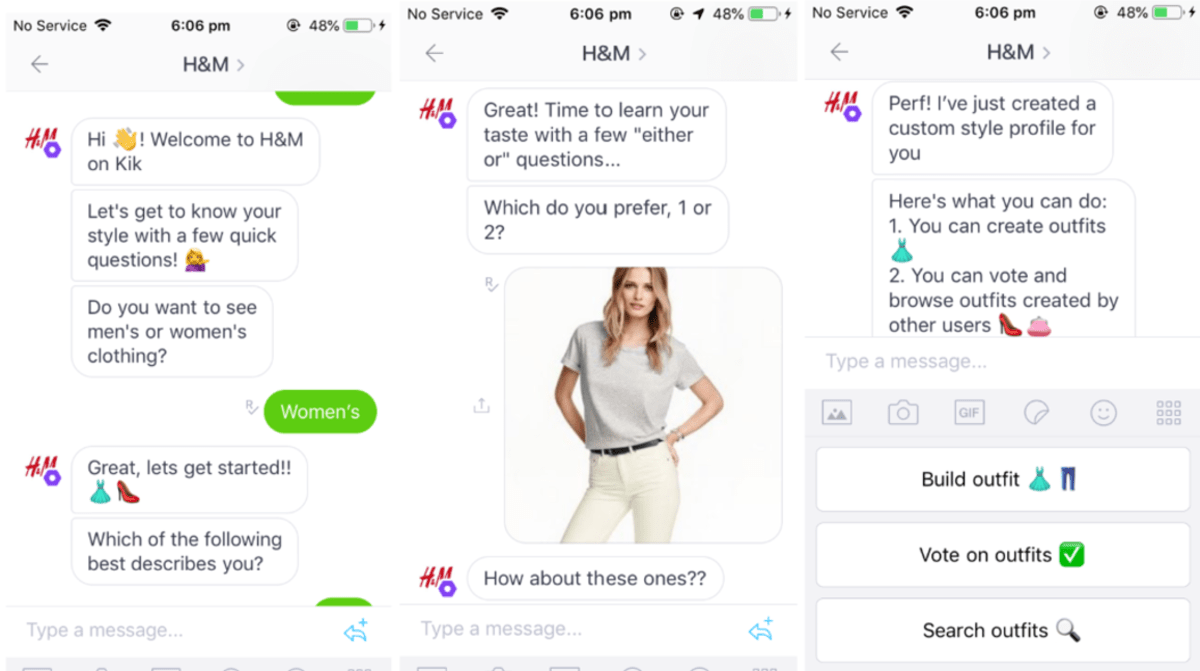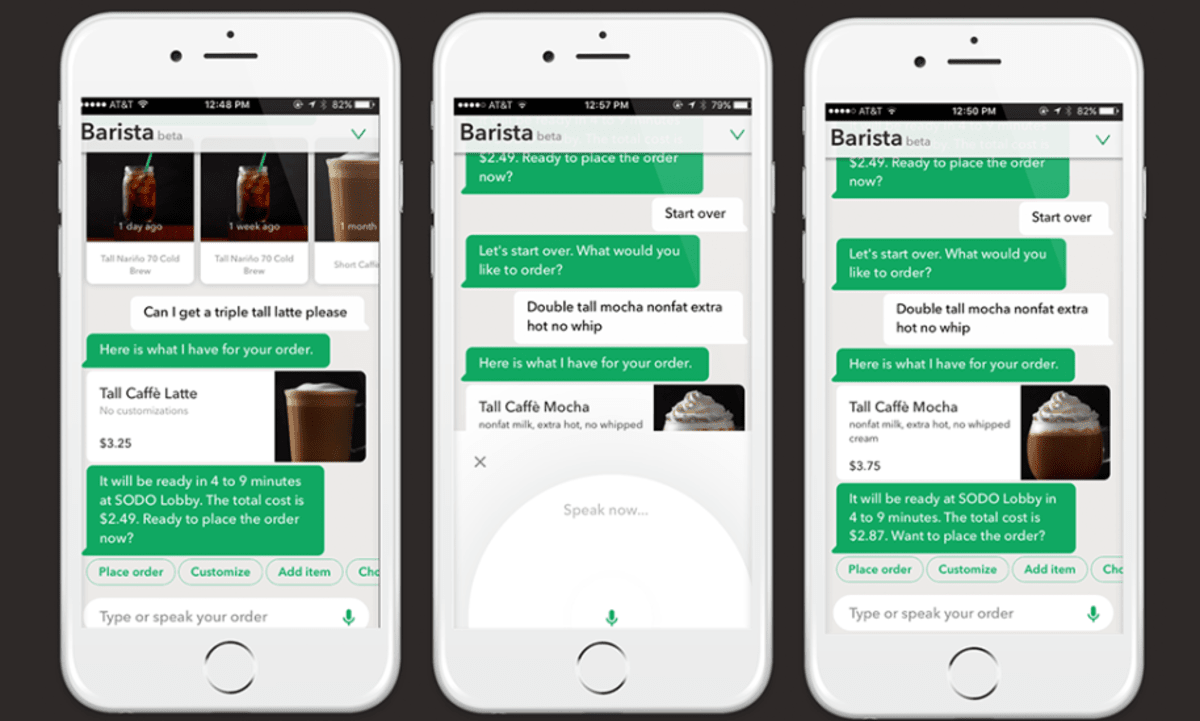What is conversational commerce?
Conversational commerce, in simple terms, is a way of online shopping that relies on conversations and messaging. It involves using tools like chatbots and messaging apps to help customers make purchasing decisions, complete transactions and receive support.
From a customer's point of view, it's a more interactive and convenient way to shop. For businesses, it's a great way to enhance the overall customer experience through conversations, whether with human representatives or automated systems.
This method blurs the boundaries between traditional in-store and online shopping, offering real-time assistance and personalization. It has evolved over the past decade, incorporating various tools such as AI, bots and messaging platforms to enhance and support the shopping experience.
Conversational commerce also includes features like in-app messaging, customer support and integration with payment systems within third-party messaging apps. It redefines the customer journey, offering new opportunities for brands and customers to connect with each other.
What’s the difference between conversational commerce and social commerce?
Ever wondered how conversational commerce and social commerce differ in the world of online shopping and customer interactions? Let's explore the basic differences.
Aspect | Conversational commerce | Social commerce |
Primary focus | Focused on real-time shopping interactions through text-based conversations and chatbots | Focused on integrating shopping directly into social media platforms, combining the social experience with shopping |
Mode of interaction | Interactions are text-based, happening within messaging apps, chatbots and conversational technology Customers engage in text conversations for product recommendations, purchases and transactions | Relies on a visual mode of interaction, with products seamlessly integrated into users' social media feeds Users can discover, explore and buy products without leaving the social platform |
Customer journey | Simplifies the customer journey by offering real-time support and personalized assistance during shopping It aims to create an interactive and convenient shopping experience | Transforms the customer journey by establishing a shopping environment within the social media platform itself |
Examples | Customers using chatbots for product advice, asking questions and receiving instant responses It can also involve making purchases and transactions through messaging apps | Customers directly buying products showcased in posts on platforms like Instagram |
Platform integration | Commonly integrated into websites and messaging apps, providing direct communication channels between customers and businesses It uses chatbots and AI to assist customers | Typically takes place within social media platforms It leverages the social environment and integrates shopping naturally as part of the user's social experience |
Why is conversational commerce important?
Now, let's dive into the many ways conversational commerce can transform your customer interactions and drive your business forward.
1. Reduce cart abandonment
Online retailers often face the problem of customers abandoning their shopping carts. Conversational commerce offers solutions to tackle this issue. By using conversational chatbots, sending proactive messages and ensuring quick responses, you can encourage your customers to complete their purchases. This not only reduces cart abandonment but also enhances the shopping experience, resulting in increased sales and happier customers.
Read More: How to reduce shopping cart abandonment with Live Chat
2. Enhance customer engagement and loyalty
Conversational commerce boosts customer engagement and cultivates loyalty. By integrating chatbots and live chat into websites and social media, you can provide convenient ways for your customers to explore products, receive recommendations and get their questions answered. This personalized approach, across web, mobile and social channels, builds authentic and memorable interactions.
Recognizing and consistently serving loyal customers creates trust and strengthens the customer-brand relationship. Additionally, using chatbots and voice bots improves the customer journey, making it easier for customers to access information and support, further strengthening their bond with your brand.
3. Enhance sales opportunities
Conversational commerce offers businesses with AI-driven automations, promoting upselling and cross-selling. It engages customers through web widgets, proactive notifications and AI chatbots — enabling product recommendations, promotions and personalized discounts. Additionally, personalized product suggestions and proactive outreach to past customers drive purchase decisions, while quick responses and seamless team communication accelerate sales.
4. Gather customer insights
Conversational commerce provides a rich source of customer data and real-time feedback (often delivered through chatbots after a purchase). It includes natural conversations, surveys and chatbot-delivered messages to collect valuable insights. This information can be used to enhance chatbot performance, offer a personalized experience and address customer needs consistently.
5. Get qualified leads
Conversational commerce simplifies lead generation and conversion. Now, even small businesses can use automation without costly custom software development or large staff. These automated systems ensure inquiries reach the right person verifying leads or authenticating customers. Additionally, providing customers with messaging options instead of phone calls improves engagement, with benefits like seasonal discounts, expert advice and quick answers that boost purchasing decisions.
How to use conversational commerce in business
Conversational commerce has rapidly transformed the digital landscape, providing businesses with unprecedented opportunities to engage customers in personalized, real-time conversations across various channels. You can incorporate this approach to customer interactions into many areas of your organization to create better experiences.
1. Customer service enhancement
Real-time assistance: Embed messaging widgets in your apps or product pages, allowing customers to conveniently message your brand, ask questions, seek help or request information about your products. This real-time approach minimizes friction and encourages conversions by offering immediate support.
Live chat engagement: Use live chat opportunities to engage with customers in real time on your website or app. Customers can initiate conversations to receive product recommendations, resolve inquiries or discuss any aspect of their shopping experience. Social messaging apps with verified business profiles and platforms like Instagram enhance conversational commerce experiences within the app itself.
Interesting Watch: 4 burning questions to ask before deploying live chat support
Conversational bots for automation: Conversational commerce can be used in automating various aspects of customer service. These bots are designed to deflect inquiries to frequently asked questions (FAQ) pages, route conversations to the most suitable sales representatives, and, in some cases, carry out end-to-end automated transactions.
2. Social media engagement
Social media as the new mall: With the rise of social shopping, (social media platforms have evolved into vibrant shopping hubs. Brands, regardless of their size, now have the opportunity to directly connect with customers through features like live streaming and shopping tabs, revolutionizing the way products are discovered and facilitating instant customer interactions.
Take Instagram, for instance. It offers verified business profiles, creating an enriched conversational commerce experience. With this approach, customers can shop for products, share their experiences and engage in real-time conversations. The result? Successful and hassle-free purchases.
Learn More: How to measure social media engagement effectively
Automation for seamless interactions: Conversational commerce bots are instrumental in automating these interactions. They not only facilitate conversations but also provide guidance during the customer's entire journey, from product discovery to final purchase.
3. Personalized recommendations
Unified customer profiles: Maintain unified customer profiles across all channels, ensuring that conversational data from various sources, such as voice assistants, phone calls and messaging, converges in one place.
AI and human agents collaboration: This central data hub empowers agents and AI to provide customers with highly personalized product recommendations. Rather than bombarding customers with generic suggestions, you can tailor your offerings to match their interests, preferences and historical interactions with your brand.
4. Click-to-message advertisements
Click-to-message advertisements offer a concrete example of conversational commerce in action, to deliver tangible results. These advertisements, often seen on platforms like Instagram Stories, encourage customers to initiate conversations with your brand. Through precise ad targeting, you can significantly boost customer engagement and conversion rates.
Click-to-message ads streamline communication processes, making it effortless for businesses to interact with potential customers, answer their queries and guide them toward successful transactions.
5. Search engine results
Many customers prefer the convenience of a chat over making phone calls. To meet this growing demand, businesses can leverage a system that allows customers to initiate a chat directly from search engine results or maps, irrespective of the platform they're using.
For example, when a user searches for a local business, such as a restaurant or retail store, the search engine results not only display the contact information but also offer an option to start a chat instantly. This enables customers to inquire about business hours, make reservations or ask questions about products or services without having to make a phone call.
Behind the scenes, businesses can implement automation to address frequently asked questions efficiently. A well-organized chatbot can guide customers by providing information about the business, its services or even processing reservations or orders. This approach helps to effectively manage customer inquiries without the need for additional customer support staff, providing a cost-effective and efficient solution.
This seamless integration of chat into search engine results streamlines communication and offers a more convenient experience for customers, ultimately leading to higher customer satisfaction and engagement.
6. Being future-ready
Enhance customer engagement: The emergence of generative AI showcases a transformative phase in the evolution of conversational commerce. It empowers businesses to create chatbots and voice assistants that have natural conversations and understand complex questions. For example, an online electronics store can use a voice assistant to provide product information, answer customer queries and assist with purchases.
Efficiency in customer support: Generative AI's adaptability greatly benefits customer support. Imagine a technical issue where a chatbot with generative AI comprehends the complexity and guides customers efficiently, similar to a human technician. This ensures quick issue resolution, leading to happier customers and greater trust in your brand.
Personalized conversations: Generative AI excels in generating human-like responses and adapting to various conversational styles. An online fashion retailer, for instance, can use it to provide personalized fashion advice. Customers can discuss their style preferences, and the chatbot, powered by Generative AI, can offer clothing recommendations.
Interesting Read: Will ChatGPT and Generative AI shape the future of customer service?
Advance conversational commerce tactics
Conversational commerce has come a long way from simple chatbots and canned responses. To excel in this online-driven world, you'll need advanced tactics that truly connect with your customers. Here are three pro tips to elevate your conversational commerce game:
1. Personalization beyond "Hi [Name]"
While addressing customers by their names is a great start, go further with personalized product recommendations. Analyze their past purchases and browsing history to suggest products they'll love. For instance, if a customer frequently buys running shoes, recommend the latest models, matching accessories or even exclusive discounts on related fitness gear. Make them feel like you know and understand their preferences.
2. Seamless cross-channel experiences
Today's customers don't limit themselves to a single channel. They might start on your website, continue the conversation on a mobile app and later switch to a social media platform. Ensure their journey is seamless. If they've added items to their cart, remind them about it, even if they're on a different channel. Remember their preferences and past interactions, no matter where they happen.
3. AI-powered predictive insights
Anticipate your customers' needs before they express them. AI tools can analyze customer behavior and predict their next steps. For instance, if someone has been researching summer vacation destinations, a predictive insight might prompt you to offer them travel insurance or car rental services. Proactive engagement shows you're one step ahead, making customers feel like you truly know what they want.
Real-world conversational commerce examples for inspiration
Let's explore some conversational commerce examples that showcase the real-world applications and benefits of this approach.
H&M's Chatbot Stylist
H&M, a popular fashion retailer, has integrated a chatbot stylist into its mobile app. Users can chat with the stylist to get personalized fashion recommendations based on their style preferences and occasion. The chatbot showcases product images, provides fashion advice and even suggests complete outfits. Customers can click on the product links to make purchases, making it a convenient way to shop for clothing and accessories.

Starbucks Barista Bot
Starbucks Barista Bot exemplifies the power of conversational commerce in simplifying the coffee ordering process. Customers can engage with the bot through various messaging apps, customizing their coffee orders with precision and paying securely within the chat. The bot's integration with Starbucks Rewards further enhances the experience, allowing users to earn and redeem rewards seamlessly.
Starbucks Barista Bot also offers the convenience of placing location-based orders for quick pickup, reducing waiting times for busy customers. This innovative application of conversational commerce not only streamlines the ordering process but also fosters customer loyalty by catering to individual preferences and delivering a more personalized coffee experience.

Turn your social into revenue drivers with Sprinklr Conversational Commerce
In today's digital landscape, Sprinklr's conversational commerce platform stands out as a powerful tool for brands.

You engage customers on the 30+ modern channels, build strong 1:1 relationships and convert customer interactions into sales with the following features:
Seamless omnichannel commerce
Drive up to 185% more revenue with seamless omnichannel commerce. Sprinklr’s unified platform enables complete conversational journeys across the 30+ messaging, live chat, social and app channels your customers prefer — helping you create premium commerce experiences at every touchpoint on their journey.
Personalized customer experience
Create personalized CX that makes customers 80% more likely to convert. Activate seamless end-to-end experiences, from awareness campaigns on paid media to proactive, cross-channel engagement that recommends the right products and services — sparking customer desire, building relationships and delivering the value that turns prospects into revenue-driving customers.
AI-powered bots and sales support
Reduce CX costs by 40-60% with AI-powered bots and sales support. Scale global engagement efforts efficiently by leveraging industry-leading AI across multiple languages to detect customer intent, power conversational bots and arm your sales specialists with relevant real-time data.
Final thoughts
Conversational commerce is fast emerging as a powerful tool for online shopping, incorporating real-time communication channels like chatbots and voice assistants to engage customers. While crafting an effective strategy and maintaining conversations may be challenging initially, it's important to recognize that every meaningful relationship begins with a simple chat.
By adopting conversational commerce with a human touch and empathy, you can create a welcoming environment — ultimately enhancing customer satisfaction and driving success.
Frequently Asked Questions
Conversational commerce is a business approach that relies on real-time communication tools like chatbots, messaging apps and voice assistants to help a brand engage with customers, answer questions and facilitate smooth transactions.
Thank you for contacting us.
A Sprinklr representative will be in touch with you shortly.
Contact us today, and we'll create a customized proposal that addresses your unique business needs.
Request a Demo
Welcome Back,
No need to fill out any forms — you're all set.


![The Best Time to Post on LinkedIn [By Days & Industry]](https://images.ctfassets.net/ukazlt65o6hl/dwAyaQmzYQJRQGd34YkeR/8ea930b229b90a4d3b7d6521a2272ff3/Banner_image.jpeg?w=750&h=428&fl=progressive&q=70&fm=jpg)